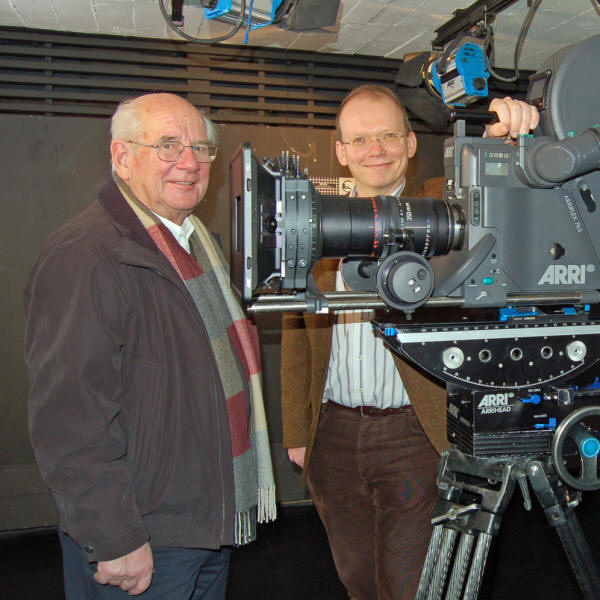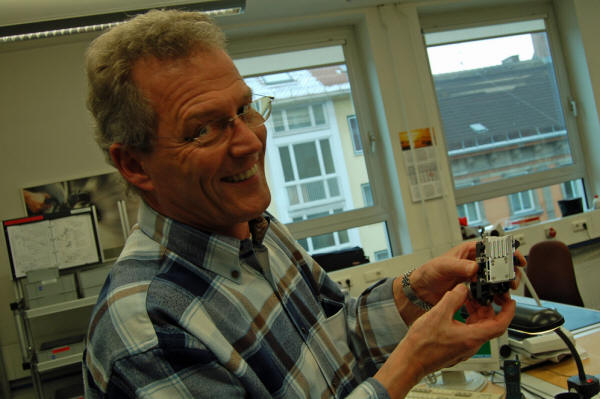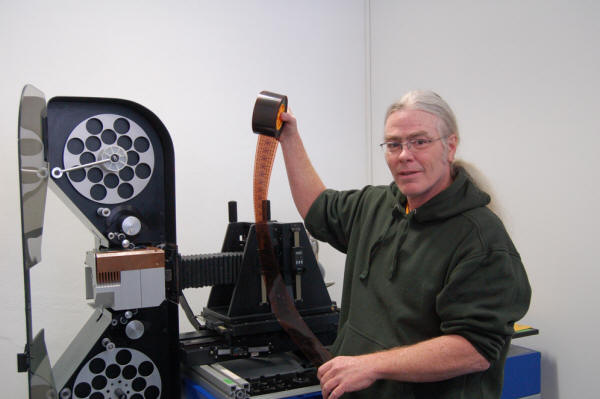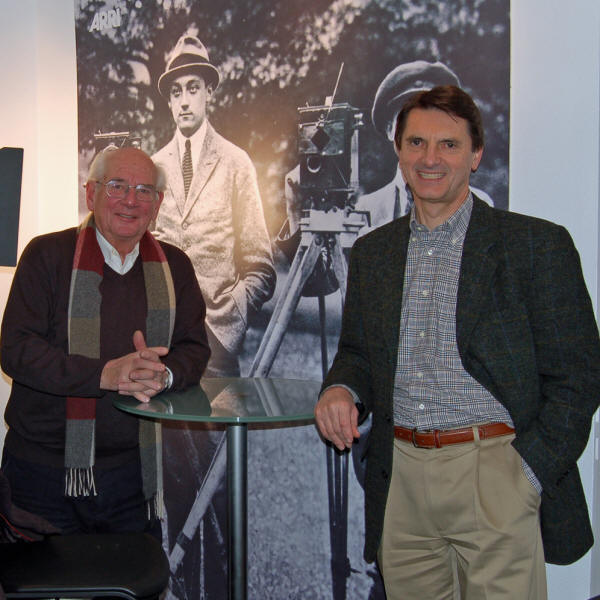A Visit to ARRI in München |
Read more at in70mm.com The 70mm Newsletter |
| Written and photographed by: Thomas Hauerslev | Date: 29.09.2014 |
 Our
host this morning Mr. Michael Koppets and Mr. Gerhard Fromm with the ARRI
765. Our
host this morning Mr. Michael Koppets and Mr. Gerhard Fromm with the ARRI
765.In the late 1990s, Mr. Gerhard Fromm invited me to come to München to talk about movies and cameras. In 2009 I was finally on my way to see him. The visit included a visit to the world famous ARRI Group in München. Gerhard welcomed us near the end of the train platform and drove us to Türkenstrasse 89, the home of the ARRI Group, the world leading manufacture of motion picture cameras and everything else a movie production needs. I had sent a letter of introduction in advance, per Gerhard’s advice, to the manager Mr. Franz Kraus explaining how we would be pleased to visit ARRI. The ARRI name was certainly not unfamiliar to me. ARRI have made cameras in all formats, size and shapes since 1917, and had recently moved into the digital world too. Besides cameras, the ARRI group also manufactures lighting equipment for movie production, runs their own cinema, "Neues ARRI Kino", and is also involved in restoring films, digitising film, and post production. • Go to Gallery: A Visit to ARRI in München We parked the car and were welcomed by Mr Kraus and Michael Koppets (Senior Engineer Research & Development). Mr. Koppets was our host for the day and would show us around the facility. In the foyer all ARRI's achievements and awards were on display, including several Oscars. We were encouraged to take as many pictures as we liked, except at their clients in the camera rental department. ARRI is a very open and accomodating company and both Orla and I felt very welcome this morning. I knew the name Arriflex, the name of their camera and their lighting equipment but I had no idea that ARRI Group is a complete studio, laboratory (with familiar smell of developer chemicals) and post production facility as well as being the place where they build and service their cameras. The facility at Türkenstrasse covered a whole block of buildings except one house on the corner of the building, which is the home of a bakery. For decades, the owner of the bakery has refused to sell his house to August Arnold and Robert Richter, the founders of ARRI. We started the tour in the lens department where new lenses from Carl Zeiss are calibrated in a small room with a purpose built Kollimator hanging from the ceiling. The ARRI Ultra prime lens is mounted, and the light in the kollimator is turned on so the ARRI prime is projecting light onto a white wall. |
More
in 70mm reading: Gallery: A Visit to ARRI in München Interview With Otto Blaschek - The Making of ARRI 765 Re-visiting Large Format With Gerhard Fromm In the Movies with Gerhard Fromm Arriflex's ARRI 765 Films photographed with the ARRI 765 65mm camera Internet link: arri-kino.de Arnold & Richter Türkenstr. 89 D - 80701 Muenchen |
 A
member of the ARRI team with a small piece of Arriflex camera part. A
member of the ARRI team with a small piece of Arriflex camera part.ARRI's Staff checks for many things like sharpness and correct distance measurement. It is important to make sure there are no faulty elements in the lenses. The lenses are checked with very high contrast, so scratches show up as gray areas on the high contrast image. It was interesting to see the edge-to-edge sharpness of the lenses with extreme short focal length. Some years ago Franz Klaus bought a 65mm scanner for large format film operations, and everybody asked him ”What do you want with that?”. Well, it turned out to be a good addition to their fleet of ARRI 35mm and 16mm scanners. The 65mm scanner is run by Steven Stueart, and can even scan 15 perf 70mm. Each frame is scanned in 3 parts and later stitched together in a computer. For many years ARRI have been on the leader on the scanner market with their ARRIscanners. I noticed some 70mm film was stored in Danish butter cookie cans. Today [2009, ed] it is normal to scan the 35mm negative and edit the film digitally. Once the film is edited, the digital files are later burnt/written onto a 35mm negative film, from which prints for the cinema are made. In theory, all prints are "first generation" prints which means sharper and better 35mm prints in cinemas and happy customers. ARRI cameras have been built for more than 90 years. Today the 35mm flagship cameras are the 435, 235 and 535 cameras as well as the the ARRI 765 65mm camera and the brand new 416 16mm camera. |
|
 Steven
Stueart with the large format scanner, demonstrating a small roll of 65mm
negative film. Steven
Stueart with the large format scanner, demonstrating a small roll of 65mm
negative film. The latest generation [2009, ed] of digital cameras; the D20 & D21 are also being produced in great numbers. All cameras are built from ground up in Türkenstrasse. We were fortunate to be shown some details of this line of manufacture. Everything is documented to the smallest detail and the highly skilled staff are sitting in very pleasant rooms in a friendly environment where they assemble these mechanical masterpieces. Everything is built in-house, and next door was the service department where all cameras are serviced and repaired. Not only are the latest cameras serviced, all ARRI models are serviced and repaired there. Older ARRI cameras are also updated, repaired and serviced. Older cameras can have electronics updated or their mirrors changed. Unlike Panavision, ARRI Group sell their cameras to studios and film makers. One director of considerable fame, who owned his own ARRI cameras was Stanley Kubrick. Each member of the staff has his own set of tools and they are all kept in mint condition for this specialized work. Everywhere we went, we met only smiling and happy ARRI people who were eager to talk to us and were very open to our questions and the visit. It appears many have had very long careers at ARRI, and the company continues to recruit new staff. The highly skilled staff can work in other department after their own wish, and develop their skills in all ARRI's mechanical shops. It is important for ARRI to keep the "know-how" in the company, and make sure the staff have a good working environment. A loyal and dedicated staff will stay for many years if they are happy with their work. |
|
 Mr. Gerhard Fromm and
Mr. Franz Kraus, head of ARRI Group Mr. Gerhard Fromm and
Mr. Franz Kraus, head of ARRI GroupARRI sells their equipment to camera rental companies all over the world. Asia and India are very big markets. ARRI even sells camera to Panavision, which does not make their own cameras any more. Panavision adapts ARRI cameras for their use and lenses. We left one building with cameras and lenses, walked across the court yard to the camera rental department and downstairs to the preparation rooms. Camera crews are preparing and testing their camera sets before they go out and shoot the film. We were told ARRI had arranged a ARRI 765 for us to see. And there it was, in all its majesty - the ARRI 765 on a tripod. More than 20 years ago, ARRI decided to build a series of 65mm cameras. 12 cameras were built at the ARRI factory in Vienna and the new camera was premiered in 1989. We learned it was built at the old Eumig factory and by their former engineers. The 765 seems to be a large camera, but it is not large when you compare with older unblimped Panavision and Mitchell 65mm rack-over cameras. The 765 is self blimped, which means it is very quiet and does not need a big sound proof box around it to minimize camera noise. It’s very stylish in ARRI's design and look very much like its smaller 35mm cousins - only larger. One of ARRI's technicians explained how it worked, and Gerhard Fromm was listening and studying the camera eagerly. Gerhard was a camera engineer for many years, and once worked with the MCS 70 camera in the 1960s. • Go to Interview With Otto Blaschek - The Making of ARRI 765 • Go to Films photographed with the ARRI 765 65mm camera Not only was the ARRI 765 on display for us to have a look at, ARRI also brought out some of the standard flight cases containing all the accessories for the camera. One box contained the lenses, a 24mm, a 110mm and a 50mm. I seem to recall the normal basic complement is 12 cases in a complete camera package for the 65mm camera. It is a lot of boxes to keep track of, and they contain equipment, lenses, magazine, camera body and accessories. |
|
 The ARRI 765 The ARRI 765On the top floor in one of the buildings, ARRI have a small screening room with 20 seats. Mr. Henning Radelin showed us in after taking a few images outside. In the screening room - with digital projection - we saw “As Good as it Gets” which was shot partly in 65mm with the ARRI 765. It was a pleasure to view the clear bright pictures from this DCP, and the scenes filmed in 65mm really were outstanding. It didn't hurt, that the girls on the screen looked terrific too. Henning also told us about 4-5 65mm short films which Michael Ballhouse made for the director of the Venice Festival a few years ago. Short vignettes filmed in large format. Only 1 minute long. We didn't see the short films. ARRI sponsors and produces film too, and they house a large post production facility ARRI in Türkenstasse is a huge complex of many buildings including two studios, TV production, camera shop, prepping facilities and a laboratory. The tour was very interesting and we were greeted by smiling and friendly people everywhere as we walked from department to department. In camera manufacturing Mr. Koppets told us how they continue to recruit new staff and train them in-house. Making cameras is very specialized work and require highly skilled staff. Many people have been employed by ARRI for many years. To avoid boredom with the same job everyday, the staff are offered to work in different departments. In the same building as the ARRI Group, is also a cinema called ARRI Kino. A state of the art cinema complete with film and digital projectors. It was pleasing to see a Philips / Kinoton DP75 and an FP30 in the very small and compact projection room. Endless racks with sound equipment and cables, plus a 5-platter non rewind system. It was as if you were in a film set like "Das Boot" - there was NOT room for anything but showing films. The day ended with lunch with Mr. Klaus and Mr. Koppets in a nearby restaurant. Our four-hour visit had come to an end, and we left ARRI around 15 o'clock in the afternoon. I'd like to extend my warmest thanks to the ARRI group for making this visit possible and making us feel so welcome that Friday morning.. |
|
|
Go: back
- top -
back issues
- news index Updated 22-01-25 |
|
